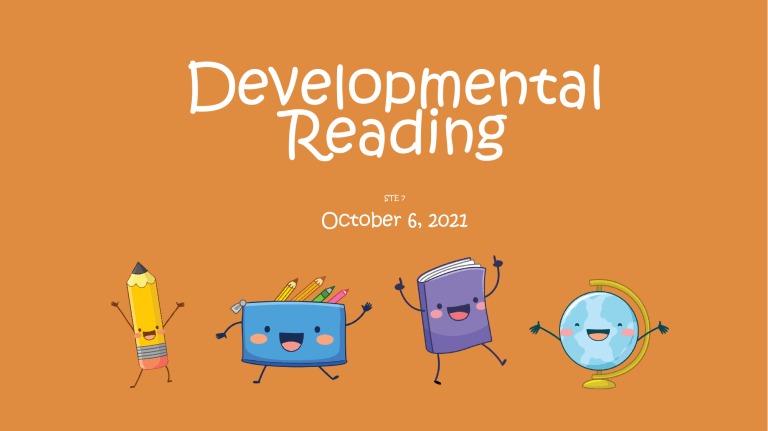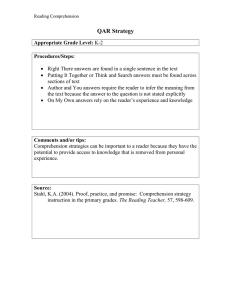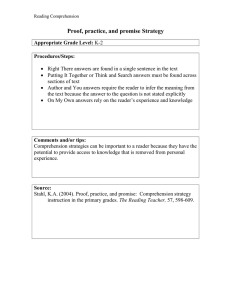
Developmental Reading STE 7 October 6, 2021 Outline of Lessons • Lesson 1: What is Reading? • Lesson 2: Process that Affects Reading • Lesson 3: The Psychology of Reading • Lesson 4: What Developmental Reading Means Lesson 1: What is Reading? • Reading is an active dialogue between the author and the reader and is the basic tool for learning in all subjects. • Reading experts explain that reading is a subtle and complex process that involves five stages: o Sensation o Perception o Comprehension o Application o Integration Step 1: Word Perception • Word Perception: the ability to pronounce the word as a meaningful unit. • Word Perception involves SENSATION • Reading takes place when the eyes pause or rest. • Span of Perception: distance or the number of words between fixations. Step 2: Comprehension • Comprehension: the skill in making individual words construct useful ideas as they are read in context. o Comprehension requires the fusion of meanings or separate words into a chain of related ideas. o Types of Comprehension Literal Level: One reads to understand the passage-its main thought, specific details, sequence and directions to be followed. Implied Level: involves making inferences, sensing relationships, drawing conclusions and recognizing the author’s purpose, tone and feeling. Step 3: Reaction • Reaction: a judgment on what the author said. • It includes the ability to judge accuracy, quality and worth. • The emotional level of reaction requires value judgment, background experience, and the ability to recreate sensory images. • Reaction occurs only when comprehension is fully realized and is affected by culture. • Experience becomes the foundation stone of the reading process. Step 4: Integration/Assimilation • Integration: the ability to assimilate idea or concept into one’s background of experience so that it is useful as part of the individual’s total experience. o It is determined by the reaction of the reader. o If the ideas are accepted, they become a part of his total experience. o On the other hand, wrong concepts are corrected, and new insights are acquired. o Integration also involves applying ideas acquired in problem solving. Recognition Span • It is the distance or the number of words between fixation point and is also called Span of Perception. • The printed word acts as a trigger to release the meaning which the reader already possess. Rate • It refers to the speed of recognition, comprehension, reaction and integration. • Rates are flexible. They vary according to the reader’s purpose and the difficulty of the materials. Skills • To do the task known as the decoding process, one should possess these certain skills: o Use of sight vocabulary and configuration memory. o Use context clues to determine pronunciation and meaning. o Determine pronunciation and meaning through analysis of the structure or parts of words consisting of its roots and affixes and inflected or derived in form. o Relate the sound of the spoken word to its visual or graphemic symbol, a process referred to as Phonetic Analysis. o Use a dictionary to determine the pronunciation and meaning of words resistant to analysis through use of other skills. Lesson 2: Process that Affects Reading • Several reading experts have analyzed and described the processes that affects reading. Miles Zintz (1972) summarizes them as follows: o Social Process o Psychological Process o Physiological Process o Perceptual Process o Linguistic Process o Intellectual Process 1. Reading is a Social Process • Reading is affected by one’s attitude, loyalties, conflicts, and prejudices. • It is augmented by social acceptance, self reliance, and cooperation in a group. 2. Reading is a Psychological Process • How one feels about oneself and about others affects the reading process. • Emotional stability determines one’s comfort in the reading situation. • Defense Mechanisms like inhibitions, repression, projection, aggression, rationalization, and nervousness are responses to anxiety to all types of situation. 3. Reading is a Physiological Process • One must be able to focus on a line of print and move along the line to make return sweeps, note similarities and differences, and discriminate figure ground relationships. • One needs skills in auditory and visual discrimination, verbal expression, sync-tactical maturity, eye-hand coordination, and motor skills to execute mechanical skills associated with reading. 4. Reading is a Perceptual Process • It utilizes perceptual clues: size, shape, color, combinations of sounds and letters, figure-round relationships, relationships of the part of the whole, ordering and sequencing. 5. Reading is a Linguistic Process • It requires sound-symbol relationships, understanding of the intonation, stress, rhythm, pausing, and tone sequences. • Reading is dependent on context meanings and grasping the ideas in whole thought units. • It requires acceptance of social variations in language, non-standard usage, figurative language, and slang. 6. Reading is a Intellectual Process • It is dependent on vocabulary, memory, verbal reasoning, perceiving relationships, generalizing, critical judgment, and accommodation to extreme individualized differences. Successful Reading Act RECOGNITION The reader Recognizes the words and grasps the ideas presented. COMPREHENSION Then he Reflects on their significance, relates them, and sees their implications. REACTION If he is to benefit from those ideas, he Reacts thoughtfully to what he reads by weighing its values and the soundness of judgments or conclusions or apprehend the context as to value and significance. APPLICATION Finally, if reading is to help him, he Applies the idea acquired to solve problems or to direct his own activities. Lesson 3: The Psychology of Reading • EYE MOVEMENTS o Reading makes constant use of the eyes. o Readers can accelerate reading growth by widening the span of recognition through phase reading or chunking. o Photographs show that reading involve these eye movements: o Fixation o Interfixation o Return Sweeps o Regression o Span of Recognition o Duration of Fixation Fixation • The vertical mark made when the eyes stop, and the film continues to move. • Good readers have fewer fixations than poor readers. Interfixation • It is the short horizontal line caused by the eyes which move from one stopping point to another. Return Sweeps • Return sweeps are long slanting lines resulting from the quick swinging back of the eyes from the end of the line to the beginning of the next line. Regression • Are backwards or right to left movements made in a reverse direction. • Usually, readers regress as a result of habit, although some do so to double check a point. • Even good readers make some regressions, but they are usually fewer than those made by the poor ones. Span of Recognition • It is the number of words taken every time the eyes stop. • It is synonymous with the length or distance recognized within one fixation. Duration of Fixation • The length of time the eyes pause. • Most readers make an average of four eye stops per second. • SENSATION AND PERCEPTION o The most basic stage of reading revolves around the ability to identify and recognize words, because the word represents the smallest unit of visual identification and meaningful recognition. o Sensation and perception occurs when the eyes are so aimed that light from the printed symbols hits the foveal areas of the retina. Lesson 4: What Developmental Reading Means • Developmental Reading refers to a comprehensive reading program which consists of several periods or stage. • These periods usually coincides with the individual’s development stages of growth. • It is believed that one progresses gradually in acquiring and developing certain skills. Developmental Reading Developmental Reading Reading Readiness Nursery Kindergarten Beginning Reading Grade 1 Refinement and Wide Reading Rapid Growth Grade 2 Grade 3 Grade 4 Grade 6 High School College I. Reading Readiness • This is the period when the child gets ready to read. • With the guidance of his/her teachers, the child acquires a functional listening and speaking vocabulary. • He/she acquires skills in auditory and visual discrimination, motor-ocular coordination, and critical thinking. • Gradually, the child acquires a basic sight vocabulary using picture, action, configuration, and context clues. • He/she learns to attack words with phonetic and structural analysis. II. Beginning Reading • This is the initial process of learning to recognize words, phrases, and sentences as symbols for ideas. • Beginning reading includes: • Getting acquainted with an idea or an experience; • Seeing how the combination of symbols that stand for the idea looks; • And remembering how the combination of symbols may be distinguished from other combinations. III. Period of Rapid Growth (Expanding Power) • Most children will have mastered the techniques of reading upon reaching this stage of rapid growth or expanding power. • However, interesting materials should be used in developing vocabulary, comprehension, locational, and simple organizational skills. • At this point, free reading is also encouraged. IV. Period of Refinement (Growth in the Use of the Reading tool) • Learners do a great deal of serious and interpretative reading during this period. • Reading becomes a tool for purposeful study in other subjects. • Skills in vocabulary, comprehension, literary appreciation, the use of references in the library, and creative interpretation are carried on to high school where both extensive and intensive readings are needed in all subject areas. • Extensive reading: the recreatory type one does as he curls up in his/her favorite chair and leisurely enjoys reading. • Intensive Reading: the detailed, careful reading one does in class or in the library. Questions?



